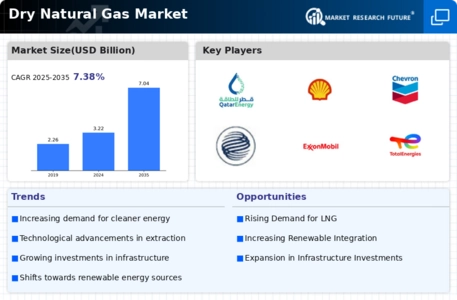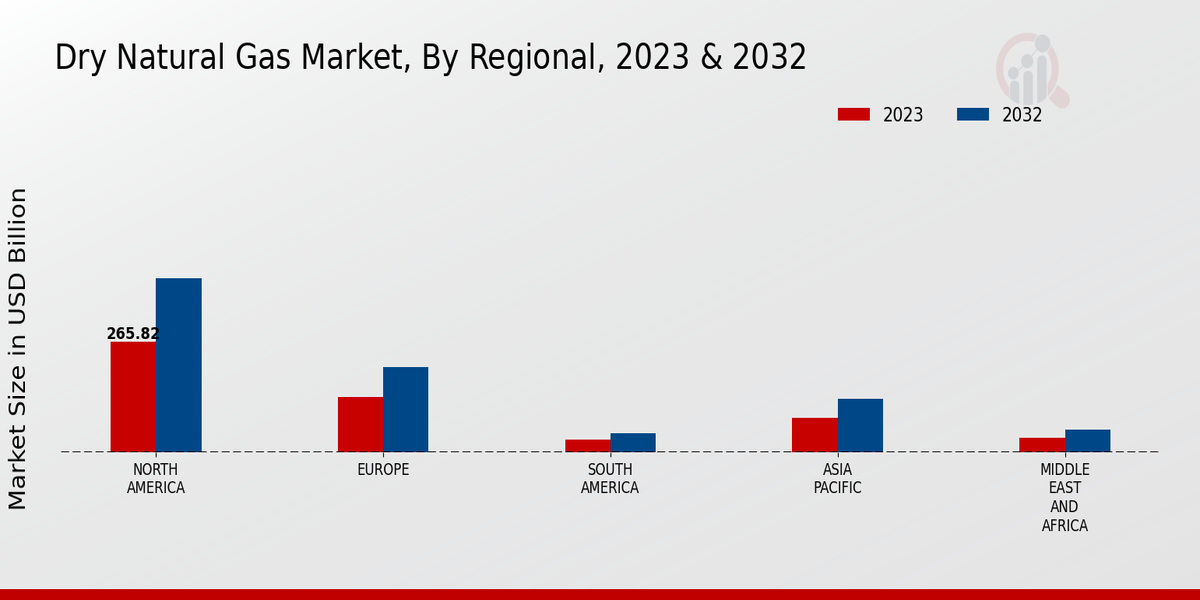Market Growth Projections
The Global Dry Natural Gas Market Industry is projected to experience substantial growth in the coming years. With a market value of 3.22 USD Billion in 2024, the industry is expected to expand significantly, reaching an estimated 7.04 USD Billion by 2035. This growth trajectory indicates a robust compound annual growth rate (CAGR) of 7.38% from 2025 to 2035. The increasing demand for cleaner energy sources, technological advancements, and supportive government policies are key factors driving this expansion. As the global energy landscape evolves, the dry natural gas market is poised to play a pivotal role in meeting future energy needs.
Rising Demand for Clean Energy
The Global Dry Natural Gas Market Industry is experiencing a notable increase in demand for cleaner energy sources. As countries strive to reduce greenhouse gas emissions and transition to sustainable energy systems, natural gas is often viewed as a bridge fuel. In 2024, the market is projected to reach 3.22 USD Billion, driven by the growing adoption of natural gas in power generation and transportation. This shift is particularly evident in regions such as Europe and North America, where regulatory frameworks are increasingly favoring natural gas over coal and oil. The industry's growth is likely to continue as governments implement policies aimed at promoting cleaner energy alternatives.
Global Energy Security Concerns
Concerns regarding global energy security are increasingly influencing the Global Dry Natural Gas Market Industry. As geopolitical tensions and supply chain vulnerabilities persist, countries are seeking to diversify their energy sources and reduce dependence on a single fuel type. Natural gas is often viewed as a reliable and flexible energy option that can enhance energy security. This trend is particularly evident in Europe, where nations are actively seeking to reduce reliance on Russian gas supplies. The emphasis on energy independence is likely to bolster the demand for dry natural gas, contributing to the market's growth trajectory in the coming years.
Government Policies and Incentives
Government policies and incentives play a crucial role in shaping the Global Dry Natural Gas Market Industry. Many countries are implementing favorable regulations and financial incentives to promote the use of natural gas as a cleaner energy source. These policies often include tax breaks, subsidies, and investment in infrastructure development, which facilitate the growth of the natural gas sector. As nations commit to reducing carbon emissions and enhancing energy security, the demand for dry natural gas is likely to increase. This supportive regulatory environment is expected to drive market growth, aligning with global efforts to transition towards more sustainable energy systems.
Increasing Industrial Applications
The Global Dry Natural Gas Market Industry is witnessing a rise in industrial applications, particularly in sectors such as chemicals, fertilizers, and manufacturing. Natural gas serves as a critical feedstock for the production of ammonia, methanol, and other chemicals, which are essential for various industrial processes. This growing reliance on natural gas is expected to contribute to the market's expansion, with projections indicating a market value of 7.04 USD Billion by 2035. Industries are increasingly recognizing the benefits of using natural gas as a cleaner alternative to other fossil fuels, thereby driving demand and supporting the overall growth of the market.
Technological Advancements in Extraction
Technological innovations in extraction and production processes are significantly influencing the Global Dry Natural Gas Market Industry. Enhanced techniques such as hydraulic fracturing and horizontal drilling have revolutionized the extraction of natural gas, making previously inaccessible reserves economically viable. These advancements have led to a surge in production, particularly in the United States, which has become a leading producer of dry natural gas. As a result, the market is expected to grow at a CAGR of 7.38% from 2025 to 2035, reflecting the ongoing improvements in efficiency and cost-effectiveness associated with these technologies. This trend underscores the importance of innovation in meeting global energy demands.


















